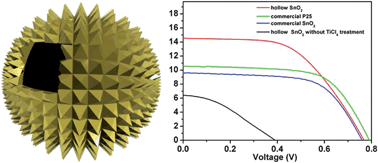SnO2 hollow nanospheres enclosed by single crystalline nanoparticles for highly efficient dye-sensitized solar cells
Abstract
The amount of

* Corresponding authors
a
School of Chemistry and Environment, Beihang University, Beijing, China
E-mail:
guolin@buaa.edu.cn
Fax: +86-10-82338162
Tel: +86-10-82338162
b
Department of Chemistry, Beijing Key Laboratory for Microanalytical Methods and Instrumentation, Tsinghua University, Beijing, China
E-mail:
jhli@mail.tsinghua.edu.cn
The amount of

 Please wait while we load your content...
Something went wrong. Try again?
Please wait while we load your content...
Something went wrong. Try again?
H. Wang, B. Li, J. Gao, M. Tang, H. Feng, J. Li and L. Guo, CrystEngComm, 2012, 14, 5177 DOI: 10.1039/C2CE06531B
To request permission to reproduce material from this article, please go to the Copyright Clearance Center request page.
If you are an author contributing to an RSC publication, you do not need to request permission provided correct acknowledgement is given.
If you are the author of this article, you do not need to request permission to reproduce figures and diagrams provided correct acknowledgement is given. If you want to reproduce the whole article in a third-party publication (excluding your thesis/dissertation for which permission is not required) please go to the Copyright Clearance Center request page.
Read more about how to correctly acknowledge RSC content.
 Fetching data from CrossRef.
Fetching data from CrossRef.
This may take some time to load.
Loading related content
